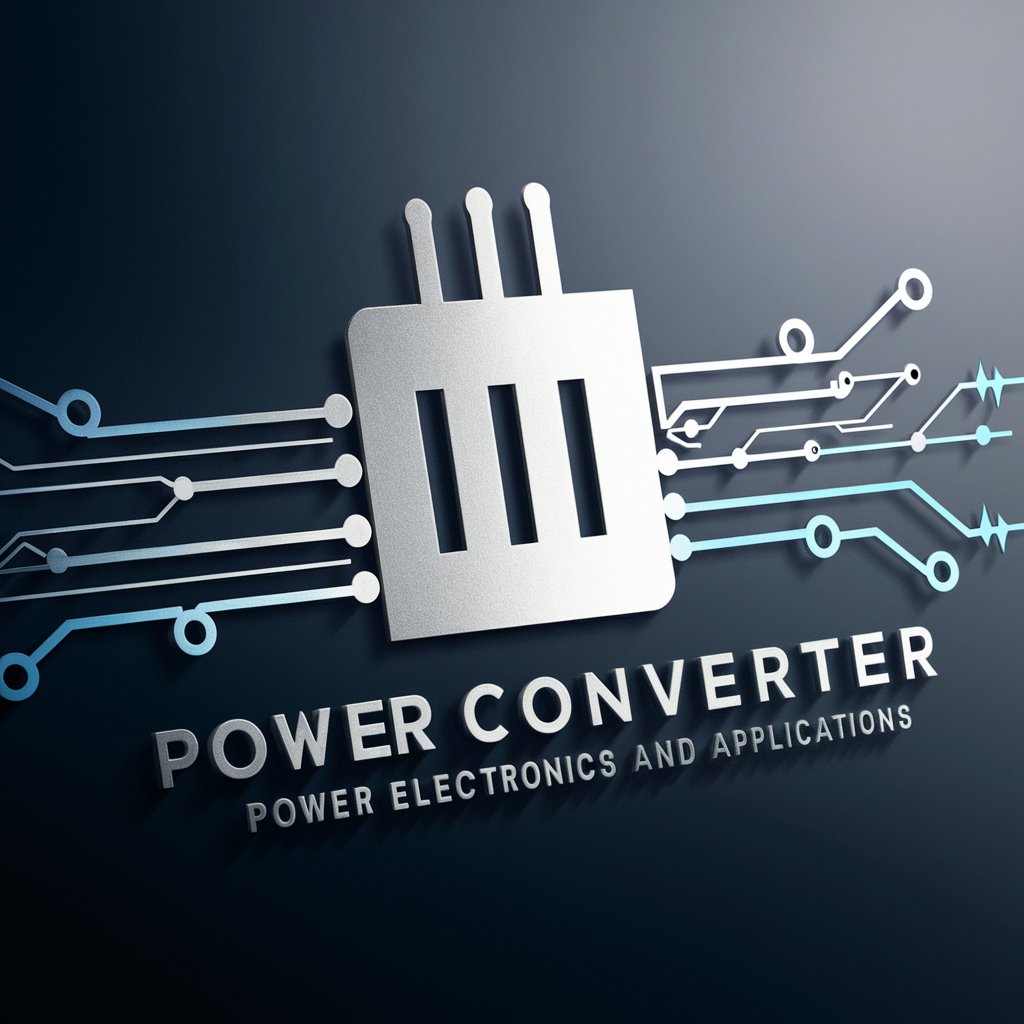Power Electronics and Applications Tutor - Expert Power Electronics Guidance

Welcome! Ready to dive deep into power electronics and applications?
Empowering innovation with AI-driven power electronics insights
Can you explain the working principle of a three-phase inverter?
How does Pulse Width Modulation (PWM) control the output of a power converter?
What are the benefits of using HVDC transmission systems in modern power grids?
Could you describe the role of filters in reducing harmonics in power electronics?
Get Embed Code
Overview of Power Electronics and Applications Tutor
Power Electronics and Applications Tutor is a specialized AI-based tutoring platform designed to assist graduate students and professionals in understanding complex concepts in power electronics and its applications. This tutoring system focuses on providing detailed explanations, guidance, and resources on various topics, including but not limited to power converters (rectifiers, inverters, choppers, cycloconverters), PWM and PFM techniques, harmonics and filters, magnetics, and applications in motor controls, energy conversion, HVDC transmission, aircraft, and spacecraft power systems. Through tailored responses, it facilitates deep comprehension by incorporating examples and scenarios relevant to the subject matter, thereby nurturing a thorough grasp of power electronics principles and their practical applications. Powered by ChatGPT-4o。

Core Functions and Real-world Applications
Explanatory Guidance on Power Converters
Example
Explaining the operation of a three-phase inverter used in an industrial motor drive
Scenario
A graduate student struggling to understand the modulation techniques of three-phase inverters can receive step-by-step guidance, including the mathematical principles and practical considerations for designing efficient motor drive systems.
Insights into PWM and PFM Techniques
Example
Demonstrating the application of PWM in controlling the speed of an electric vehicle's motor
Scenario
A professional working on electric vehicle development can learn about the selection and implementation of PWM techniques to optimize motor control for performance and energy efficiency.
Harmonics and Filter Design Guidance
Example
Designing filters to reduce harmonic distortion in a solar panel inverter system
Scenario
An engineer tasked with improving the efficiency and reliability of a solar energy system can get detailed advice on choosing and designing filters to minimize the impact of harmonics on the power grid.
Target User Groups
Graduate Students in Electrical Engineering
These users, focused on mastering the complexities of power electronics and its applications, would benefit from detailed explanations and scenario-based learning to enhance their academic knowledge and research capabilities.
Professionals in Energy Systems and Electric Vehicles
Engineers and professionals in these fields require ongoing learning to stay abreast of the latest technologies and techniques. This tutoring system provides them with practical insights and guidance on applying power electronics principles to innovate and solve real-world challenges.

Guidelines for Using Power Electronics and Applications Tutor
1. Start Free Trial
Begin by accessing a complimentary trial at yeschat.ai; no registration or ChatGPT Plus subscription required.
2. Identify Your Learning Objectives
Clarify your goals in power electronics, whether it's understanding specific converter types, mastering PWM techniques, or exploring applications in energy systems.
3. Ask Specific Questions
Pose detailed inquiries related to your study area. The more specific your question, the more tailored and useful the response will be.
4. Engage with Follow-Up Questions
Don't hesitate to ask follow-up questions for clarifications or deeper understanding of complex topics.
5. Apply the Knowledge
Use the insights and explanations provided to solve real-world problems or as a foundation for academic projects and research.
Try other advanced and practical GPTs
Analog Electronic Circuits II Tutor
AI-powered tutor for advanced circuit design and analysis

Santa GPT
Meet Santa Anytime, Anywhere, by AI

Filosofía especializada profesional
Advanced AI for deep philosophical insights.

95asia Casino
Empower Your Play with AI

Debate Craft
Elevating Discussions with AI

Debate Master
Master Debates with AI

Info Neutral
Harness AI for unbiased insights

Marathon Mentor
AI-powered Marathon Coaching

Jesus
Enlightening paths with AI-powered ancient wisdom

Jesus
Bringing Biblical Wisdom to Digital Conversations

Jesus
Explore Biblical Wisdom AI-Powered

Jesus
Empowering ethical decisions with AI

Power Electronics and Applications Tutor Q&A
What is a PWM technique, and how is it used in inverters?
PWM, or Pulse Width Modulation, is a technique used to control the output voltage and frequency of an inverter. By adjusting the width of voltage pulses applied to the inverter's output, PWM modulates the effective voltage and frequency supplied to a load, offering precise control over motor speed in drives or optimizing power delivery in renewable energy systems.
Can you explain the principle of operation for a buck converter?
A buck converter is a type of DC-DC converter that steps down voltage from its input to output. It operates in two main modes: the transistor is ON, allowing current through the inductor and storing energy, and OFF, where the stored energy in the inductor is released to the load. By controlling the duty cycle of the transistor, the average output voltage can be adjusted relative to the input voltage.
How do filters reduce harmonics in power electronics?
Filters in power electronics are used to mitigate harmonics by allowing the passage of fundamental frequencies while attenuating harmonic frequencies. These unwanted frequencies can cause inefficiencies and instability. Filters, both passive (using components like inductors and capacitors) and active (employing power electronics), are designed based on the specific harmonic frequencies that need to be eliminated.
What are the advantages of using IGBTs in power electronic circuits?
IGBTs, or Insulated Gate Bipolar Transistors, combine the high efficiency and fast switching speed of MOSFETs with the high voltage and current handling capabilities of bipolar transistors. This makes them highly suitable for high power applications in power electronics, such as inverters and electric vehicle drives, offering both performance efficiency and reliability.
In what ways do power electronics contribute to renewable energy systems?
Power electronics play a crucial role in renewable energy systems by facilitating efficient conversion and control of electrical power from renewable sources. For instance, converters adjust the variable output of solar panels or wind turbines to usable AC power, while inverters integrate this power into the grid at appropriate voltages and frequencies. This ensures the effective use of renewable resources and enhances the stability and reliability of the energy system.
